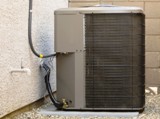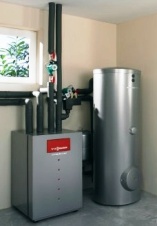Heat pumps: we warm ourselves in the cold
 What are the reasons that prevent us from using waste heat to heat homes? Using the example of heat pumps, which are widespread in the world, the difficulties with their implementation in the CIS countries are considered.
What are the reasons that prevent us from using waste heat to heat homes? Using the example of heat pumps, which are widespread in the world, the difficulties with their implementation in the CIS countries are considered.
To make sure that heat pumps exist and work effectively, you don't have to go far. It is enough to visit the kitchen and look at the refrigerator. Sub-zero temperatures reign inside, and a hot heat exchange grill on the back signals the successful extraction of heat from your products.
Heat pumps are often referred to as reverse refrigerators. This analogy is not entirely accurate. The physical principles of operation of a refrigerator and a heat pump are identical, they differ only in design and purpose: the refrigerator extracts heat from a closed volume, "throwing" it into the environment. On the contrary, the heat pump extracts low-temperature heat from the outside, open environment, giving it eventually to the closed volume of the room.
 The principles of operation of heat engines were substantiated already in the first half of the 19th century, but refrigerators were more fortunate: the need to store food turned out to be a more pressing problem than heating homes, especially since there were no problems with fuel in those days for heating.
The principles of operation of heat engines were substantiated already in the first half of the 19th century, but refrigerators were more fortunate: the need to store food turned out to be a more pressing problem than heating homes, especially since there were no problems with fuel in those days for heating.
For the first time, interest in heat pumps arose in post-war Europe, when the ruin and the lack of basic necessities forced the search for non-standard ways of heating homes. But the most powerful impetus for the improvement of heat pumps was the energy crisis of the 1970s. The sharp increase in the price of energy resources has made it economically profitable to use low-temperature heat carriers: water in reservoirs, geothermal heat, hot waste water from cities.
By that time, the industry had already developed and produced reliable and environmentally friendly systems for various applications: from low power for individual cottages to powerful heating systems for building complexes.
Heat pumps operating with a wide variety of media (air, water, soil) with automated pump control and management systems are now available on the market. But the most modern technology will not give the desired results if mistakes are made when choosing the power of the heat pump or when installing the heating system.
To do this, it is necessary to orient yourself in several key characteristics that determine the efficient operation of a heat pump. The most important of them is the "heating coefficient", i.e. the ratio of the amount of thermal energy generated to the electrical energy consumed. For modern systems, it ranges from 3.5 to 4.
And here the nuances begin.The manufacturer indicates this value for the most favorable operating mode of the heat pump, i.e. for a minimum temperature difference between the external heating medium and the heating circuit. For example, at an external temperature of 10 degrees Celsius (soil at a depth of 150 m.) and a temperature of the heating circuit of 40 degrees (warm floor), the coefficient will really be about 4. But already at 60 degrees it drops to 2, and at 80 degrees it is equal to 1. V In this case it is easier and cheaper to use conventional electric heaters or boilers.
The second main problem is the calculation of the collector (heat extraction circuit) of the heat pump. Depending on the composition of the soil, the heat extraction varies from 10 W / m for sand pipes to 35 W / m for wet clay soils. This is in case of horizontal placement of the collector. For a vertical reservoir, it is necessary to know the geological composition of the layers, since it is necessary to drill either a deep (more than 100 m) well or a system of wells tens of meters deep.
Hence the conclusion: it is simply impossible to do without the participation of a specialized organization or company that will conduct a study, make a project and determine the composition of the heating system. A horizontal collector requires no drilling, but laying hundreds of meters of pipes involves digging the same number of trenches up to 2.5 meters deep, so your well-maintained area will look like a bomb site when the job is done.
The installation of a vertical tank will require drilling to a depth of more than 10 meters, and this, in addition to research and design work, is associated with obtaining permits from various organizations.Today, the subsoil of the earth is the property of the state, and it, in the face of officials, can become a more serious obstacle than the prices for equipment and work on the introduction of heat pumps.
Finally, an estimate of the cost of the heat pump with operation. For a villa with a heating area of 200 m2, a heat pump with a capacity of about 18 kWh of heat energy will be needed. The collector pipes will be about 400 meters long with an optimistic heat removal rate of 50 W/m. Equipment with such capacity from leading German companies costs approximately 6,000-7,000 euros, depending on the configuration. Drilling or excavation works - within 3000 euros. Add the project, the approvals and get the sum of 10,000. This is a criterion for judging whether it is worth it for an ordinary resident to install a heat pump today and when it will pay off.
For organizations and enterprises that build new premises, it is now possible to provide heating with heat pumps. Such costs, against the background of a continuous increase in energy tariffs, can be recovered in 3-5 years. But for the population for which the state has established preferential tariffs or subsidized energy costs, the use of heat pumps will be unprofitable for a long time.
